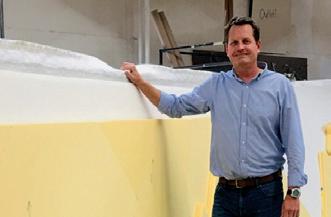
4 minute read
Corecell ™ Ten Years of Excellence and Slamming Performance
Serving the boatbuilding industry
Crucial to the design of high-performance structures within any industry is knowing how the materials will perform under various conditions. Gurit's Corecell™ M Foam is one of these materials that has been rigorously tested by Gurit engineers to provide marine customers with an assurance of its Core Impact Performance - Dynamic Testing Results capabilities and helping optimise their structures. Gurit has embarked with an independent research institute, the University of Auckland’s Center for Advanced Composite Materials, on a detailed investigation of the impact resistance of foam cores.
Long-term reliability for Marine applications
Corecell™ M Foam was first launched over ten years ago and quickly developed a reputation for itself as the go-to foam for marine applications. It is a structural foam core using a SAN polymer base developed to deliver one high performance product for all marine applications, and is ideally suited to slamming areas, superstructures, and hull and deck areas. Since its launch, the material has proven itself over and over again with unmatched toughness, long term reliability, proven quality, and excellent thermo-formability.
Today the foam features in numerous boats around the world from high performance racing yachts to superyachts and its capabilities have been proven with extensive testing showcasing its benefits for the marine industry. Advanced testing at the University of Auckland
In Auckland, New Zealand, Gurit engineers worked closely with the academics at the University of Auckland Centre for Advanced Composite Materials and at Gurit’s own internationally accredited mechanical testing laboratory to undertake static and dynamic testing on SAN, PVC, and PET foam cores. The team discovered that dynamic energy absorption rather than shear elongation is the most suitable measure to determine a core material’s ability to survive a slamming impact. The testing conclusively proved that Corecell™ M Foam has superior performance when involved in an impact. It was able to absorb more than twice the dynamic energy absorbed by the generic PVC foams of equal density, and more than ten times that absorbed by PET foam. It was found that strength and elongation, the two properties currently used to select and design cores for the slamming area of a hull, are not representative of the ability of the core to survive a slamming impact. Instead, a test method has been developed in order to be able to measure the most relevant property for slamming; Dynamic Energy Absorption The results validate a truth long known in the marine industry: even if on datasheets the strength and elongation of PVC, and even PET, match these of M-foam, in a real impact, Gurit Corecell™ M-foam is able to absorb much more energy. Gurit Corecell™ M-foam, The marine foam with unmatched toughness, for slamming applications.
See the full article for the Energy absorption impact test results comparing Corecell™, generic PVC and PET foam. Corecell™ M, PVC and PET have similar static energy absorption. However, Corecell™ M has superior performance when loaded dynamically / in an impact: Corecell™ M energy absorption increases when loaded dynamically.
Resin-savings by thermoforming
Another benefit of using Corecell™ M Foam is the ability to thermoform the foam to fit. Gurit engineers worked closely with the team at Curve Works who specialise in thermoforming using their adaptive mould technology. Together they evaluated the resin uptake of thermoformed Corecell™ versus Corecell™ with both single cut and contour scrim. Using Corecell™ M100, 30mm thermoformed to 1200mm radius, the team found the material had a similar resin uptake to a flat plain sheet. This means that a 73% resin saving is achieved when compared with single cut foam and 138% savings compared with contour scrim foam. Dynamic testing of the thermoformed core also confirmed that it was able to absorb the same level of dynamic energy as virgin material. Thermoforming is thus the process of choice to fit the core in the forward slamming areas that are typically curved.
After ten years in the market, the benefits of Corecell™ M Foam are well known and appreciated. Shape spoke with some of the shipyards that are benefitting from the material:

Aaron Crawford, Sabre Yachts
Aaron Crawford, President at Sabre Yachts USA

Mark Richards, Grand Banks Yachts & Palm Beach Motor Yachts
Mark Richards, CEO at Grand Banks Yachts & Palm Beach Motor Yachts Australia.

Warrick Yeoman, Shipyard Manager at North Sea Boats Indonesia
www.gurit.com/corecell







